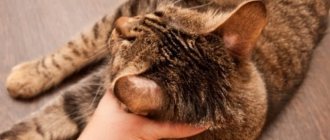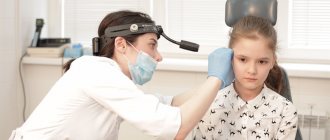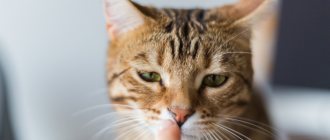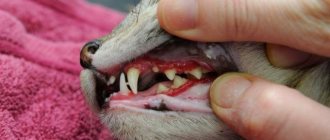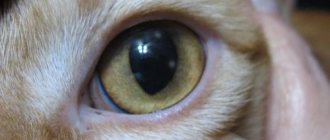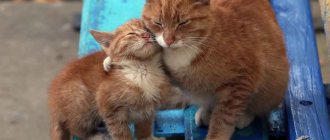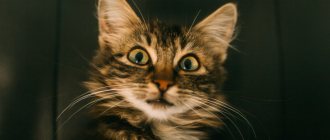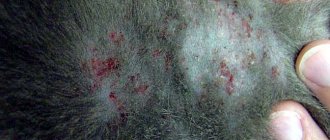Imaverol
Products from Europe
- +7 (495) 487-10-35
- Moscow, Pyatnitskaya street, 74
home
Order and delivery
FAQ
Reviews
Articles
Contacts
Throughout their lives, cats often encounter microsporia, a dermatological disease of fungal origin. Being a causative agent, fungi of the genus Microsporum enter the skin, germinate and penetrate the hair follicle, causing brittleness and hair loss.
How does infection occur?
- through direct contact with an infected animal or person (often carriers are homeless and street people);
- with indirect contact through household items (toys, furniture, bedding);
- through the external environment (spores may be in grass or soil).
Fungal spores are very viable: they persist in animal fur for up to 5 years, and in the external environment for up to 2 months.
Not every encounter with a pathogen results in the development of microsporia: the body of both cats and humans is protected by immunity. The weaker the immune system, the higher the susceptibility and risk of infection.
Who is most susceptible to the disease?
- kittens and older animals (over 10 years);
- pregnant and lactating cats;
- free-range pets;
- Persian and Himalayan breeds;
- long-haired cats;
- animals in nurseries and shelters.
Can a person or another pet get shingles?
It is important to remember that dermatophytosis is a contagious disease to other pets and humans. However, infectiousness also depends on the immunity of the animal or person in contact with the sick person.
The incubation period ranges from one to three weeks, and the manifestation of clinical signs depends on risk factors.
Main risk factors:
- age (young and older dogs and cats get sick more often);
- damaged skin (presence of abrasions and scratches);
- concomitant diseases (for example, immunodeficiency in cats);
- stress.
Long-haired cats are often carriers of dermatophytosis type M. canis. About 10–90% of cats are so-called asymptomatic carriers (without showing clinical signs). Up to 90% of cases of human dermatophytosis are caused by the same type of M. canis and the source of infection is cats.
But a person (or pet) can also become infected from a dog. Yorkies and hunting breeds are predisposed to dermatophytosis.
Infection occurs when fungal hyphae attach to a weakened organism. Subsequently, they descend into the hair follicles, in which the fungus forms spores. Subsequently, clinical symptoms appear and the pet can infect the person or animals with which it has been in contact, especially if their immunity is weakened.
In cats, the muzzle area, ears, and forelimbs are often affected. In dogs - head, neck, limbs.
Be careful, microsporia!
Currently, there is an increase in the number of cases of microsporia. Children get sick more often. In all cases, the cause of microsporia was contact with sick stray cats and dogs. Sick animals infect children who bring them home, play with them, and put them in bed. Then the owners throw the sick cat or dog out into the street, instead of taking it to a veterinary hospital for treatment.
Microsporia is a fungal disease characterized by damage to the skin and hair. The causative agents of fungal diseases persist for a long time in the external environment and are resistant to chemical and physical factors: ultraviolet radiation, freezing, and exposure to low concentrations of disinfectants. Unsatisfactory hygienic conditions, an abundance of stray animals, high temperature and air humidity contribute to the spread of the causative agent of this infection.
Manifestations of microsporia in animals are characterized by areas of baldness on the skin. Infection occurs through direct contact with a sick animal or objects infected with hair or scales (combs, hats, underwear, etc.). The causative agent of microsporia, the microsporum fungus, is very stable in the external environment. In hair, in flakes of skin, wool, located in sandboxes, in the dust of entrances, basements and attics, it retains the ability to become infected for several years.
From a sick person to a healthy person, this disease can pass through various contaminated objects - hats, combs, bedding, clothing.
Infection is also possible in hairdressing salons if the necessary hygiene rules are not followed. The incubation period for microsporia is 5-7 days.
At the site where the fungus has invaded, a swollen spot appears, pale pink in color with clear boundaries in the form of a raised ridge of bright red color, that is, the lesion has the appearance of a ring.
At the same time, vellus hair can be affected, which complicates the treatment of the disease. The number of lesions is from 1 - 3 to several dozen, their diameter ranges from 0.5 to 3 cm. Most often, lesions are located on the skin of the face, neck, forearms and shoulders. Moderate itching may be bothersome.
Damage to the scalp occurs mainly in children 5-12 years old. Foci of microsporia of the scalp are located mainly on the crown, in the parietal and temporal regions. Usually these are 1-2 large lesions ranging from 2 to 5 cm in size, with round or oval outlines and clear boundaries. Along the periphery of large lesions there may be screenings - small lesions with a diameter of 0.5-1.5 cm.
At the beginning of the disease, a peeling area forms at the site of infection. After a week, the process spreads to the hair itself, which becomes fragile, breaks off above the level of the surrounding skin by 4-6 mm and looks as if it has been trimmed (hence the second name of the disease - “ringworm”).
Prevention measures
- Children with microsporia should not attend schools and kindergartens until they have fully recovered.
- It is necessary to follow sanitary and hygienic rules, that is, use only individual hats, clothing, have a separate bed, towel, comb, washcloth and other personal items.
- Children should not be allowed to interact with stray animals. Kittens or puppies adopted into the home should be shown to a veterinarian. Don't let children take pets to bed.
- In case of contact with a sick animal, you must wash your hands with soap, lubricate scratches and abrasions with 5% iodine, change clothes, boil the removed items or iron them with a hot iron.
- Wash domestic cats and dogs with soap and water as needed, prevent fleas from appearing on them, and be sure to show them to a veterinarian at least once a year.
- If flaky spots or lesions appear on the skin or head, you should immediately consult a dermatologist.
What needs to be done to prevent further spread of the disease among others
- It is necessary to boil all underwear and bed linen used by the patient; it is best to destroy hats.
- A sick child should not communicate with other children during treatment.
- If the patient uses a shared bathroom, then after bathing it must be washed with hot water and disinfected with chlorine-containing products.
- All family members and contact persons in child care institutions are subject to examination by a dermatologist.
Remember! Failure to consult a dermatologist in a timely manner and self-medication complicate diagnosis, lead to the spread of rashes and the disease becoming chronic, which can ultimately lead to significant hair loss and the spread of infection in the environment.
Treatment of microsporia should be carried out under the supervision of a dermatologist. More often it is outpatient and does not require hospitalization of the patient. You only need to regularly visit your doctor to monitor the course of the disease. Hospitalization may be necessary only if there are any concomitant pathologies or (short-term) for a final diagnosis.
The course of treatment for microsporia can last quite a long time. This is due to the high resistance of the pathogen to various medications.
The main criterion for stopping the course of treatment is not the disappearance of symptoms, but a special microbiological analysis. If the scalp is affected, 3 scrapings are made with a five-day break. In addition, the hair is illuminated with a fluorescent lamp (Wood's lamp), which detects fungi. When lichen is localized on the skin, 3 scrapings are made with a three-day break. If all tests are negative, the patient is considered fully recovered and the course of treatment is stopped. This decision must be made by the attending physician.
Treatment for microsporia is prescribed by a doctor . If lichen is localized on the scalp, after hair removal, you can wash it with antifungal soap. You can wash your hair with lotions and shampoos containing selenium sulfide, in a concentration of at least 2.5%. Selenium has the property of destroying fungal spores and helps speed up recovery. However, products with selenium can only be used if there is no suppuration or crusts.
In severe cases of lichen, you should wash your hair with selenium shampoo every day; in mild cases, two or three times a week is enough.
All family members living in the same area as someone with microsporia can also wash their hair with selenium shampoo to prevent fungal infection. Disinfect and place separately all personal items of a patient with ringworm - combs, combs, towels, hats, bed linen, etc.
Take special care to ensure that children do not grab potentially infectious objects. Do not allow other family members to play or be in close contact with the sick person.
Do not scratch the affected area. If microsporia is detected in one of the family members, everyone living in the same area as the patient must be examined. Do not use ointments with hormonal components. The hormone will not speed up treatment, but it may do a disservice. Hormones relieve inflammation, as a result of which, after using ointments containing them, redness on the skin disappears, which people mistakenly consider to be a successful recovery and the disappearance of signs of infection. It is necessary to carefully observe hygiene, and do not allow the child’s colleagues and classmates to touch the lesion. You should not give a comb, clothing, shoes or other personal items to healthy people, as they may be contagious.
Do not scratch the affected areas, even if you really want to - be distracted by doing any tasks that require high concentration. If a child is sick, distract him with games. Unfortunately, nothing can be done at night while you sleep to prevent scratching of the affected area.
Therefore, while sleeping, wear protective gloves on your hands so as not to damage the skin with your nails when scratching. If microsporia is detected in one of the family members, it is best to undergo examination for everyone living in the same area as the patient.
When treating ringworm on smooth skin, you can, in addition to those prescribed by your doctor, use ointments with miconazole or clotrimazole. These ointments can alleviate the subjective condition. Do not use ointments with hormonal components, such as cortisone. The hormone will not speed up treatment, but it may do a disservice. Hormones relieve inflammation, as a result of which, after using ointments containing them, redness on the skin disappears, which people consider a successful recovery and the disappearance of signs of infection. But treatment must be continued, because if you stop it, a relapse will occur after a while.
Treatment should be carried out until there is no fungus in the scraping and the symptoms of infection on the skin completely disappear. A sign of recovery is the flattening of the rash and the drying out of abscesses, if any. In this case, the skin may become covered with scales and begin to peel off severely.
Complete recovery can be determined as follows: close your eyes and run your finger over the place where the lesion was. If the skin is flat and does not differ from the surrounding tissues to the touch, then we can assume that ringworm has been defeated. During treatment, the child or adult can go to school and work.
It is necessary to carefully observe hygiene, and do not allow the child’s colleagues and classmates to touch the lesion. You should not give a comb, clothing, shoes or other personal items to healthy people, as they may be contagious.
Dermatovenerologist E.S. Gavrilova.
Print Email
- Back
- Forward
Signs characteristic of lichen
Typical symptoms of this disease are:
- round, hairless areas of skin;
- redness;
- peeling of the skin and crust;
- the appearance of dandruff, dulling of the coat;
- itching (not always evident).
Ringworm is usually found in a specific area of the skin, that is, it is a focal or symmetrical focal lesion; only in dogs there is a generalized form of the disease, which can cause extensive damage.
There are also less typical manifestations of dermatophytosis. So, in dogs, these are kerion (a clearly defined raised round nodular lesion, most often located in the muzzle or forelimbs) and so-called mycetomas - damage to the claws and fingers, chronic inflammation of soft tissues, caused by a fungus.
Dermatophytic mycetoma can also occur in cats . Persian cats are predisposed to this disease (in 99% of cases). The neck, back, tail, and sides of the pet are most often affected.
If you find similar symptoms in your pet, then do not put off visiting a doctor until later. Remember that there is a huge chance that you and your family members will become infected; you must follow the rules of personal hygiene and isolate the animal during treatment.
Reviews
Ringworm in its advanced form is very difficult to treat, but this is not a death sentence and we must definitely fight. The Polivac vaccine did not help my cat, the Itracon capsules did not help, he only developed severe hepatitis and he almost died. Due to the treatment of hepatitis, they temporarily stopped treating lichen, the liver failed and the cat was actually dying, there was no time for lichen. For 3 months, about 25–30% of the cat’s skin was damaged and scratched, everything was covered in bloody wounds and scabs, it was constantly itching. I put on a sweater so that I would comb my hair less. After hepatitis, there was no talk of any medications or ointments; only Imaverol was allowed. After 2 days for 3, I smeared it not on the whole cat, but only on the lesions and around them, and on the doctor’s advice I diluted it not 1:20, as written in the instructions, but first for about a month I diluted it 1:5, then 1:10 . At the beginning of treatment, she was given the immunostimulant Cycloferon in parallel. I was treated for 2.5 months, the first month it generally seemed to me that the lesions were only growing and nothing was helping. After about a month, new lesions stopped appearing and gradually began to heal, the scabs fell off and became overgrown with hair. The fur, of course, was in terrible condition after that, I was pierced with vitamins Gepavi-kel and Tetravit and the cat was transformed before our eyes, now he is a fluffy handsome man. I vacuumed and washed the premises, but didn’t really treat them; it’s simply impossible to treat them properly at home. Don't give up and don't despair, everything will work out for you.
Svetlana
https://forum.ua-vet.com/viewtopic.php?f=23&t=52776
When we were covered with a fungus, Griseofulvin helped us. It may seem too harsh to some, but we didn’t come to him right away either, it’s a pity they didn’t tell us about him earlier, and so we had to feed the entire herd with Griseofulvin. But the results were noticeable after about the first week. Give 1/6 tablet once a day. Those who have not become infected can take it for a week; patients who are sick need a course of 3-4 weeks, even if everything goes away in 1-2. But Fungin is still not worth it for a small kitten, he is very vigorous, the kitten can puke on him and, excuse me, he can vomit... Isolate the small one if possible. Well, wash the apartment with some special means, or just vinegar water.
sanguiss
Diagnosis of dermatophytosis
Diagnosis is made based on history and symptoms. Among the diagnostic methods, the doctor can offer you:
- Wood's lamp examination . In this study, the doctor sees a bright yellow-green glow from the hairs, but only 50% of M. canis strains give such a glow. You also need to remember that dust, crusts, areas of skin treated with medications (for example, tetracycline), as well as carpet fibers can glow a similar color. Therefore, a negative test result does not exclude the presence of dermatophytosis/microsporia.
- Microscopic examination . Hair/fur and crusts from the surface of the skin are taken for analysis and examined directly under a microscope. A negative result also does not exclude dermatophytosis.
- Dermatoscopy (epiluminescent microscopy) is performed using a device - a dermatoscope, but it is not a common research method in our conditions.
- Cytological examination . The specialist stains the material from the affected area with special substances, making it easier to detect damaged hair and dermatophyte spores.
- Sowing on a fungal culture . It is the most reliable research method to determine the type of fungus. The material from the affected area (hairs, scales, etc.) is inoculated onto a nutrient medium, for example, Sabouraud agar. It is necessary to wait until the fungal culture grows so that the pathogen can be unambiguously identified, so the analysis is carried out within 1–3 weeks.
- Histopathology . The specialist takes a section of the skin and conducts a histological examination of it. Detection of spores or mycelium threads in the hair follicle or epidermal cells gives a positive test result.
- PCR diagnostics is based on determining the genetic material of dermatophytes.
Sometimes multiple methods are required to make an accurate diagnosis.
How is the treatment carried out?
Use of pharmaceuticals
All medications are prescribed by a veterinarian; self-medication can worsen the animal’s condition. For recovery, it is effective to use the Veterinary Formula Antiseptic shampoo for microsporia, which contains benzethonium and ketoconazole. The Imaverol emulsion, which contains enilconazole, is effective. After completing the course of treatment, to improve the skin and coat, you can give the animal the veterinary drug “Purified, mineralized sulfur.” It is also recommended to treat cats with the drugs shown in the table:
| Drug group | Name |
| Antimycotic liniments | "Miconazole" |
| "Mikoseptin" | |
| "Yuglon" | |
| "Yam" | |
| Sprays | "Zoomicol" |
| "Kubatol" | |
| "Fungin" | |
| Pills | "Griseofulvin" |
| "Fulvicin" | |
| "Grisactin" |
Home therapy
All alternative medicine products should not replace traditional treatment and should only be used after consultation with a veterinarian.
The medicine can be prepared from equal parts of lemon juice and olive oil.
To cure your cat of microsporia at home, you can prepare a remedy from olive oil and lemon. Recipe:
- Squeeze the juice from the lemon and mix with olive oil in equal proportions.
- Warm up slightly before use.
- Moisten a cotton swab and apply 4 rubles. per day on affected skin.
The following liniment is also effective:
- Take 50 g of olive oil or Vaseline and add 20 g of propolis.
- Mix thoroughly until a uniform consistency is obtained.
- Apply to affected areas 3 times. per day.
For feline microsporia, lotions made from herbal decoctions of tansy, celandine, and wormwood help. Preparation:
- Take 5 g of herb and pour 200 ml of hot water.
- Let it brew for 4 hours, filter.
- Place the resulting herb on gauze and apply to the sore spot for up to 4 rubles. per day.
Factors of occurrence
The occurrence and development of the pathological process can be influenced by several reasons:
- reduced activity of the pet's immune system;
- influence of stressful situations;
- inappropriate hygiene requirements in the premises;
- injury to the skin.
The disease can occur in cats at any age. The risk group includes newly born kittens and animals living on the street.
Prevention, personal hygiene
It is difficult to protect yourself from microsporia - it is a situational disease that even a completely domestic pet can become infected with. But general preventive measures will help reduce risks:
- balanced diet
- immune support
- prevention of hunting of rodents (bell)
- preventive examinations
- vaccination, treatment against parasites
- avoiding stress, hypothermia, overheating
- regular skin examination, coat care
It is advisable to prevent contact with outdoor shoes and clothing. If the pet does get sick, it is isolated in a separate room and the room is disinfected with steam or an antifungal agent. Stains are treated with disposable gloves and an apron. They enter the quarantine room wearing shoe covers, leaving them there.
In order not to provoke infection, during the quarantine period you need to wash yourself without washcloths, blotting your skin with a towel - avoid mechanical rubbing of spores. Linen is boiled, clothes are washed at high temperatures. It is better to send children to relatives for a week - during this time the treatment will inactivate the fungus, it will become non-infectious.
Preventive actions
To prevent infection of the animal, you should follow the rules regarding prevention.
First of all, it is recommended to limit contact with animals living outside. Owners need to regularly examine their pet's fur and the appearance of its skin.
Ringworm in cats - main signs, symptoms, prevention and treatment of ringworm in cats (105 photos)Pancreatitis in cats: first symptoms, nutritional nuances and treatment options (125 photos and videos)
Subcutaneous mites in cats - first symptoms, treatment options and real photos of examples of parasite damage (110 photos + video)
It is mandatory to clean the living space. The animal's diet must be balanced, with special attention paid to maintaining the immune system.
